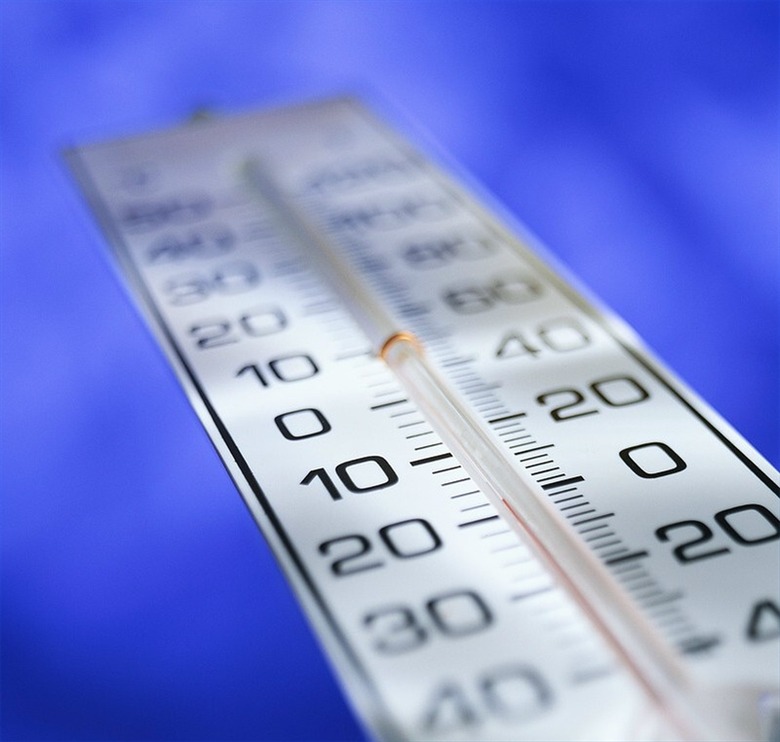How To Build A Hygrometer
Hygrometers measure relative humidity but they're good for more than just telling us where the air around us falls between arid and rainy. We need to know the relative humidity to calculate the dew point (the temperature at which water vapor will begin to condense into droplets) and the heat index (which tells you what temperature your body feels, not just the temperature of the air). The dew point and heat index are measurements we can use to determine how long people can safely work or play in high heat. They also give us an indication of how stable (or unstable) an air mass is and how likely it is to begin to provide a fertile growing medium for severe storms. You can buy a spring-operated hygrometer but it's more fun to make your own wet and dry bulb hygrometer.
Step 1
Purchase two good quality thermometers that register exactly the same temperature. Calibrations on inexpensive thermometers is not very accurate. You don't really need the precise air temperature but you need to know the difference between dry bulb and wet bulb readings. For that, any two reasonably good quality thermometers will do as long as they register exactly the same temperature before the modification you'll be doing.
Step 2
Cut the ends off a cotton shoe lace. This will be the "wick" for your wet bulb. You'll need about a foot of this material. Separate the sides and make a sleeve to slide up over the bulb on the bottom of one of your thermometers. Be very careful not to break or crack the glass. The little tube inside the thermometer is a vacuum. It it's compromised, the thermometer won't register an accurate temperature.
Step 3
Mount both of your thermometers on a single piece of wood (one by four will do) a few inches longer on the top than your thermometers. You could also mount the dry thermometer higher than the wet one. The wick of the wet thermometer should hang freely at the bottom of the mounting board. Drill a hole at the center of the top of your mounting board and thread some twine through for a hanger-handle.
Step 4
Hang your hygrometer or hold it by the twine as you soak the wick in water. You can hang your hygrometer and trail the wick into a container of water if you want to take regular readings or you can wrap the wick up and swing your hygrometer around if you don't want to leave it out permanently. Be sure to keep the wet bulb wick wet for an accurate reading.
Step 5
Read the temperature on both wet and dry bulb thermometers after a few minutes. Subtract the wet bulb temperature from the air temperature. Use this number to find the relative humidity on the humidity chart link below.
Things Needed
- Two good quality thermometers
- Cotton athletic shoe lace
- Piece of wood for mounting
- Glue or straps with tacks
- Scissors
- Drill
TL;DR (Too Long; Didn't Read)
To figure dew point from the data from your hygrometer, subtract the relative humidity from 100, then divide by 5. Subtract this number from the air temperature to get the dew point, or temperature at which the air will be completely saturated. Generally speaking, the higher the dewpoint, the more likely the formation of rain and storms. For example, if the air temperature is 85 degrees (F) and the relative humidity is 60%, the dew point would be 77 degrees. Dew points over 70 degrees are considered tropical. If you want to build a hygrometer like the first one, built in 1783 by Horace-Benedict de Saussure, a link to build a hair hygrometer is included.
Warning
Your results will not be exact because your thermometers are not professionally calibrated scientific instruments. Be sure to use cotton (or muslin) for your wet bulb wick. Other materials won't hold the water and your wet bulb thermometer will read the same as the air temperature.
Cite This Article
MLA
Reynolds, Laura. "How To Build A Hygrometer" sciencing.com, https://www.sciencing.com/build-hygrometer-4449112/. 24 April 2017.
APA
Reynolds, Laura. (2017, April 24). How To Build A Hygrometer. sciencing.com. Retrieved from https://www.sciencing.com/build-hygrometer-4449112/
Chicago
Reynolds, Laura. How To Build A Hygrometer last modified March 24, 2022. https://www.sciencing.com/build-hygrometer-4449112/
